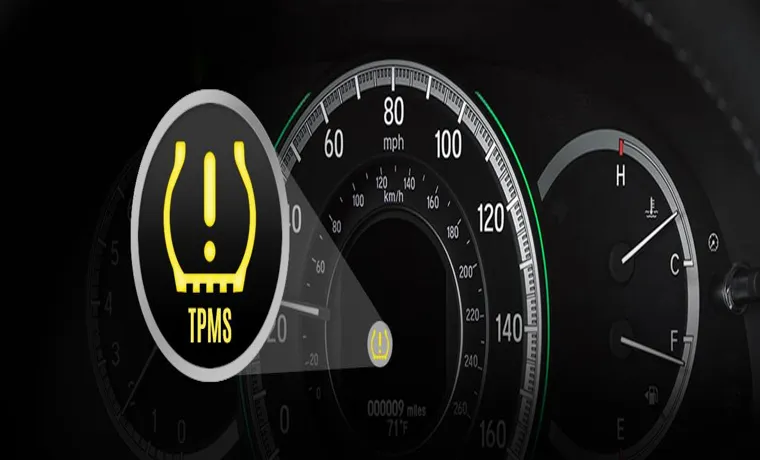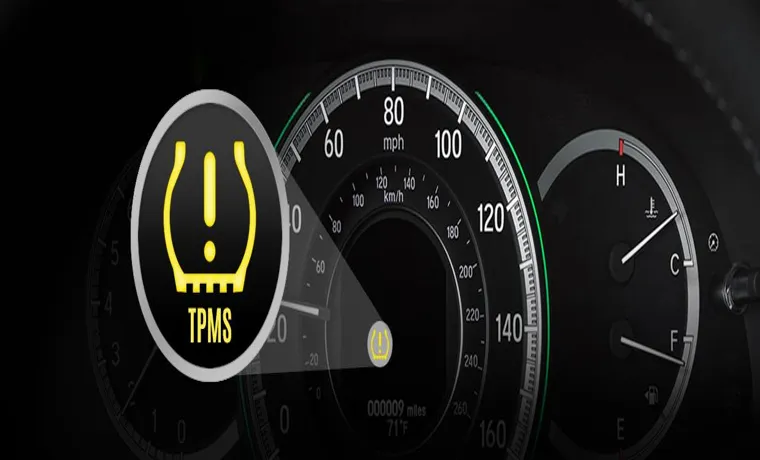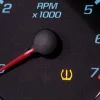Have you ever experienced a flashing warning light on your car’s dashboard that indicates a significant decrease in tire pressure? This can be quite alarming because low tire pressure can lead to reduced fuel efficiency, poor handling, and even tire blowouts. Fortunately, modern cars come equipped with tire pressure sensors to alert you of any potential issues. However, what happens when the sensor starts malfunctioning and provides inaccurate readings? Don’t fret; resetting tire pressure sensors is an easy fix that you can do at home, without having to take it to a mechanic.
In this blog, we will guide you through the step-by-step process to reset your tire pressure sensor and get your car back on the road safely.
Table of Contents
Understanding Tire Pressure Sensors
Resetting a tire pressure sensor can seem like a daunting task, but it is actually quite simple. First, locate the reset button in your vehicle. This button may be located in different areas depending on the make and model of your car.
Once you have located the button, ensure that all tires are properly inflated to the recommended PSI. Next, press and hold the reset button until the tire pressure light on your dashboard begins to flash. This may take several seconds.
Finally, release the button and wait for the light to go out. Your tire pressure sensor has now been reset and should not cause any further issues. Remember, proper tire inflation is essential for the safety and performance of your vehicle.
What are Tire Pressure Sensors?
Tire pressure sensors are tiny devices attached to car tires that monitor their air pressure. They are designed to alert drivers when their tires have low or high pressure, which can help prevent accidents and reduce fuel consumption. These sensors work by sending a signal to the car’s computer, which then displays a warning message on the dashboard.
Some sensors even allow drivers to check their tire pressure from their mobile devices. Understanding tire pressure sensors is essential for every car owner, as it can help extend the life of their tires and save them from costly repairs. It’s like having a personal assistant working with you, reminding you to check the tires and keep them inflated, just like a friend reminding you to drink water when you’re thirsty!

Why Do You Need to Reset Them?
Tire Pressure Sensors Tire pressure sensors are vital components of modern vehicles that monitor the pressure in each of the tires. These sensors alert the driver when the tire pressure drops below a specific level. This notification can help prevent accidents and potentially save lives.
However, it’s important to understand that these sensors need to be reset regularly. Over time, the TPMS system may become inaccurate or malfunction due to changes in tire pressure or damage to the sensors. By resetting the sensors, drivers can ensure that their vehicles are operating with the most up-to-date information about tire pressure.
Without resetting the sensors, drivers may experience poor fuel economy, reduced handling, and increased tire wear. To ensure maximum safety and performance, it’s important to reset tire pressure sensors regularly and pay close attention to any alerts or warnings from the TPMS system.
How to Reset Tire Pressure Sensor
If your tire pressure sensor is indicating that your tire pressure is low, it’s time to reset it. First, make sure that the tires are properly inflated before resetting the sensor. Then, locate the reset button or the reset sequence in your car’s user manual.
Usually, the reset button is found underneath the dashboard. Hold it down for a few seconds until the sensor light blinks. Once you release it, the light will stop blinking, indicating that the sensor has been reset.
If your car does not have a reset button, you can try the old-fashioned method of disconnecting the battery for a few minutes and then reconnecting it. This will reset the system, including the tire pressure sensor, and the light should go away. Remember to reset the tire pressure sensor every time you adjust the tire pressure or change your tires.
Step 1: Check the Manual
If you’re experiencing issues with your tire pressure sensor, the first step to take is to check your vehicle’s manual. The manual is an important resource that contains specific instructions for resetting the sensor on your make and model of car. It’s important to follow these instructions carefully to ensure that you reset the sensor correctly, as the process can vary between different cars.
However, if you don’t have the manual to hand or if the instructions are unclear, there are other options available to you. You may be able to find helpful information online, or you could consult a mechanic or dealership for assistance. Regardless of the method you choose, always make sure to address any problems with your tire pressure sensor promptly in order to maintain your vehicle’s safety and performance.
Step 2: Locate the Reset Button
When it comes to resetting your tire pressure sensor, the second step is to locate the reset button. This may vary depending on your car’s make and model, so it’s best to consult your owner’s manual. Typically, the reset button is located around the dashboard or near the steering wheel.
Once you’ve located it, you may need to use a small tool such as a paperclip to press and hold the button for a few seconds until the tire pressure light blinks or turns off. It’s important to note that some cars may require more involved procedures, such as entering a special mode or using a remote to reset the sensor. However, with a little bit of patience, you can easily reset your tire pressure sensor and ensure that your car’s tires are properly inflated for optimal performance and safety on the road.
Step 3: Press and Hold the Reset Button
Resetting your tire pressure sensor is a simple process that can ensure your tires are always properly inflated and ready for the road. Once you identify that your sensor needs to be reset, the next step is to locate the reset button. In most vehicles, it is located either under the steering wheel or glove box.
Press and hold the button until the sensor begins to flash, indicating it is ready to reset. Be sure to keep the button held down until the flashing stops and a solid light appears. This means the sensor has successfully reset and calibrated to the correct pressure level.
Remember, a reset tire pressure sensor can improve fuel efficiency, reduce tire wear, and, most importantly, help you avoid potential accidents on the road. Don’t forget to regularly check the pressure levels on all four tires and reset the sensor as needed!
Step 4: Release the Button After a Few Seconds
When it comes to resetting your tire pressure sensor, it’s essential to release the button after a few seconds. This step is crucial because it signals to the sensor that it needs to reset itself. Keep in mind that you’ll need to locate the tire pressure monitoring system reset button, which can usually be found underneath the steering wheel or glove compartment.
Once you’ve located the button, press and hold it until the sensor light blinks a few times. After that, you’ll need to wait for a few seconds before releasing the button. Doing so will ensure that the sensor has ample time to reset itself.
Remember, releasing the button too soon or too late can cause the sensor not to reset properly, which can lead to inaccurate tire pressure readings. Therefore, it’s crucial to take your time and make sure you follow the steps properly. With a bit of patience and careful attention, resetting your tire pressure sensor can be done quickly and easily, leading to a safer and more comfortable ride.
Step 5: Confirm the Reset
Reset Tire Pressure Sensor Once you’ve gone through the process of checking your tire pressure, you may find that you need to reset your tire pressure sensor. To do this, you will want to start with turning on your engine and ensuring that all your tires are properly inflated. Then, locate the reset button or process for your specific vehicle.
This could involve pressing a button or turning your key to a certain position. Once you have initiated the reset process, you will want to wait until the light on your dashboard or instrument panel has turned off. Depending on your vehicle, this could take anywhere from a few seconds to a couple of minutes.
Finally, to confirm that the reset was successful, take your car for a short drive and ensure that the tire pressure warning light stays off. With these simple steps, you can ensure that your tire pressure sensor is properly reset and functioning as it should be.
What If the Above Steps Don’t Work?
If you’ve followed the steps to reset your tire pressure sensor and it still isn’t working, there are a few more things you can try. Firstly, check to make sure that the sensor itself isn’t damaged or missing. If it is, you will need to replace it.
Secondly, ensure that the tires are properly inflated and that the pressure matches the specifications listed in your owner’s manual. Sometimes, the sensor won’t reset if the pressure is too low or too high. Additionally, try resetting the sensor multiple times, as sometimes it takes a few attempts to successfully reset it.
If none of these steps work, it’s best to bring your vehicle to a trusted mechanic to troubleshoot the issue. Remember that the safety of your vehicle and those on the road should always be a top priority, so don’t hesitate to seek professional help if needed.
Check the Battery
If the above steps don’t work, it’s time to check the battery. A dead battery is one of the most common reasons for a car not starting. First, make sure the battery terminals are clean and properly connected.
If they are, use a multimeter to test the battery’s voltage. A fully charged battery should read around 16 volts.
If the voltage is below 12 volts, the battery may be discharged and need to be recharged or replaced. It’s essential to keep in mind that batteries have a lifespan and will eventually need to be replaced. If your car battery is consistently causing issues, it’s time to consider getting a new one.
Remember, a healthy battery means a healthy car, so don’t neglect this crucial component.
Visit a Mechanic
If the above steps do not work, it may be time to visit a mechanic. It is important to find a reputable mechanic who will be able to diagnose and fix the issue with your vehicle. A good mechanic will be able to identify the root cause of the problem and provide a solution that will prevent the issue from happening again in the future.
Before taking your vehicle to a mechanic, it is important to do some research and read reviews to ensure you are choosing a trustworthy mechanic. Remember, it is better to spend a little extra money on a reliable mechanic than to take your chances with someone who could potentially do more harm than good to your vehicle. By taking your vehicle to a mechanic, you can have peace of mind knowing that your car is in good hands and that any issues will be resolved professionally and efficiently.
Conclusion
Resetting a tire pressure sensor may seem like a daunting task, but with the right tools and know-how, it’s as easy as pie (and we’re not talking about a flat tire)! So, the next time your car’s tire pressure sensor decides to throw a fit, take a deep breath and remember these simple steps. Trust us, you’ll feel like a tire pressure sensor reset pro in no time!”
FAQs
What is a tire pressure sensor and why is it important?
A tire pressure sensor is a device that measures the air pressure inside a tire and alerts the driver if the pressure drops below a certain level. It is important because maintaining the proper tire pressure can improve safety, extend tire life, and enhance fuel efficiency.
How do you know if your tire pressure sensor needs to be reset?
Typically, a warning light will appear on your dashboard indicating that the tire pressure sensor needs to be serviced or reset.
How do you reset a tire pressure sensor?
The process for resetting a tire pressure sensor varies depending on the make and model of your vehicle. You can consult the owner’s manual or a professional mechanic for guidance, but in general, you will need to inflate your tires to the recommended pressure, locate the reset button or procedure, and follow the steps to reset the sensor.
Can a tire pressure sensor be replaced or repaired?
Yes, a tire pressure sensor can be replaced or repaired if it is malfunctioning or damaged. However, it is important to ensure that the replacement sensor matches the specifications of your vehicle’s make and model.
What happens if you ignore a tire pressure sensor warning?
Ignoring a tire pressure sensor warning can lead to decreased fuel efficiency, reduced tire life, and increased risk of accidents due to poor traction or blowouts. It is important to address any tire pressure issues promptly to maintain the safety and longevity of your vehicle.
How often should you check your tire pressure and sensor?
It is recommended to check your tire pressure and sensor at least once a month or before long trips. You should also get them inspected and serviced as part of your regular vehicle maintenance schedule.
Can extreme temperatures impact tire pressure sensors?
Yes, extreme temperatures can cause the air pressure inside your tires and sensors to fluctuate and potentially trigger a warning. It is important to monitor your tire pressure and sensor readings during hot or cold weather conditions.



